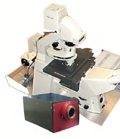9 September 2010
Teem Photonics introduce the mFab3D for complete, cost-effective 3-D micro-fabrication of microstructures
 Teem Photonics, world leader in passively Q-switched microchip lasers, introduces its new 3D Micro Fabrication Module the mFab3D, allowing the realisation of polymer, protein, metal or other biomaterial microstructures.
Teem Photonics, world leader in passively Q-switched microchip lasers, introduces its new 3D Micro Fabrication Module the mFab3D, allowing the realisation of polymer, protein, metal or other biomaterial microstructures.
Distributed in the UK and Ireland by Photonic Solutions, the mFab3D is a novel laser accessory using Two-Photon Absorption (TPA) from a 532nm Microchip laser to build micro-objects in polymer, proteins or noble metals with confocal microscopy resolution. These microscopic structures are realised as a result of a high definition photochemical process initiated at the focal point of a laser and resolution (voxel size) down to 200nm is achievable. The surface of these structures is automatically generated by the laser which is driven by 3D scan files, or CAD files (SolidWorks, AutoCad). This achievement is made possible with the use of Teem Photonics’ unique and patented picosecond compact laser technology, which enables a process with a higher chemical efficiency than femtosecond lasers while representing a cost effective solution.
The mFab3D consists of a laser module, sample module, 3D micro-fabrication software, a starting kit and inverted microscope. One of the key features of this system is the 3D micro-fabrication software which is bespoke software that offers a powerful 2D slicing method to provide much faster and more efficient fabrication.
The laser is a compact 532nm Nd:YAG Microlaser which is adapted to the microscope aperture and modulated with an acousto-optic modulator. 1064 or 532nm laser wavelengths are available at up to 40kHz repetition rate and 0.5ns pulse duration. The sample module offers piezo-electric nano-positioning capabilities of 0-100µm. Optional larger displacement piezo modules are available with up to 300 x 300 x 300 µm displacement. The 3D micro-fabrication software is capable of optimising the fabrication of complex shapes imported from standard 3D CAD files.
- Contact Information
- Name: Doug Neilson
- Email: douglas.neilson@photonicsolutions.co.uk
- Website: www.photonicsolutions.co.uk

